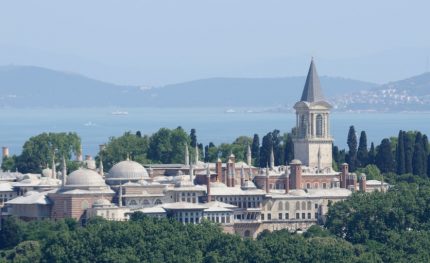What is the Ottoman Legacy Tour in Istanbul? How to Travel?
The Ottoman Legacy Tour in Istanbul is a rich and profound one, as Istanbul (formerly known as Constantinople) served as the capital of the Ottoman Empire for over 400 years. The city is steeped in history and showcases a blend of Ottoman, Byzantine, and Roman influences. Here are some key aspects of the Ottoman legacy in Istanbul and tips on how to explore them:
Historic Architecture:
 Topkapi Palace: This palace was the primary residence of the Ottoman sultans for several centuries. It’s a sprawling complex that includes courtyards, museums, and beautifully decorated rooms.
Topkapi Palace: This palace was the primary residence of the Ottoman sultans for several centuries. It’s a sprawling complex that includes courtyards, museums, and beautifully decorated rooms.
Hagia Sophia: Originally a Byzantine church, it was converted into a mosque during the Ottoman era. It’s an architectural masterpiece and an important symbol of Istanbul. You can visit Hagia Sophia with Ottoman Legacy Tour.
Blue Mosque (Sultan Ahmed Mosque): Known for its stunning blue tiles, this mosque was built during the reign of Sultan Ahmed I. It’s an active place of worship and an iconic symbol of Istanbul.
Grand Bazaar and Spice Bazaar: These historic markets date back to the Ottoman period and offer a unique shopping experience with a wide range of goods, including spices, jewelry, textiles, and more. You can visit Spice Bazaar with Ottoman Legacy Tour.
Bosphorus Strait: The Bosphorus played a significant role in the history of Istanbul and the Ottoman Empire. You can take a Bosphorus cruise to see stunning Ottoman-era waterfront mansions, palaces, and fortresses along the strait.
Suleymaniye Mosque: This mosque, built by the famous Ottoman architect Mimar Sinan, is an architectural marvel and an important religious site. It offers panoramic views of Istanbul from its courtyards.
Ottoman Cuisine: Istanbul’s food scene is heavily influenced by Ottoman cuisine. Don’t miss trying traditional dishes like kebabs, baklava, and Turkish delight at local restaurants and street vendors. You can try Ottoman Cuisine with Ottoman Legacy Tour.
Hammams (Turkish Baths): Experience a traditional Ottoman bathhouse, where you can relax and enjoy a traditional scrub and massage. You can visit Turkish Hammams with Ottoman Legacy Tour.
Museums: Visit the Istanbul Archaeological Museums and the Istanbul Military Museum to learn more about the Ottoman Empire’s history and military achievements.
How to Travel:
Visa: Check the visa requirements for your country before traveling to Turkey. Ensure you have the necessary travel documents.
Flights: Istanbul has two major airports, Istanbul Airport (IST) and Sabiha Gokcen Airport (SAW). Depending on your location, you can book a flight to either of these airports.
Accommodation: Istanbul offers a wide range of accommodations, from luxury hotels to budget-friendly hostels and boutique guesthouses. Choose one that suits your preferences and budget.
Transportation: Istanbul has an extensive public transportation system, including buses, trams, and a metro. You can also use taxis and rideshare services. Walking is a great way to explore the historic areas.
Ottoman Tours: Consider joining guided tours to explore the city’s historic sites, as they provide valuable insights and context.
Language: While Turkish is the official language, English is widely spoken, especially in tourist areas.
Safety: Istanbul is generally safe for tourists, but exercise normal precautions, such as safeguarding your belongings and being aware of your surroundings.
Currency: The currency in Turkey is the Turkish Lira (TRY). Credit cards are widely accepted, but it’s advisable to have some cash on hand for small purchases.
Exploring the Ottoman legacy in Istanbul is a fascinating journey through history, and the city offers a unique blend of cultures and experiences that make it a captivating destination.
What are the touristic places of the Ottoman Empire that you can visit with the Ottoman Legacy Tour?
The Ottoman Empire was one of the most significant empires in history, spanning several centuries and covering a vast geographical area. As a result, there are numerous tourist destinations and historic sites associated with the Ottoman Empire across various countries. Here are some key touristic places related to the Ottoman Empire:
Istanbul, Turkey:
As mentioned earlier, Istanbul served as the capital of the Ottoman Empire, and many of its iconic landmarks and historic sites are associated with the Ottomans, including the Topkapi Palace, Hagia Sophia, Blue Mosque, Suleymaniye Mosque, Grand Bazaar, and Spice Bazaar. You can visit Istanbul with Ottoman Legacy Tour ↗.
Edirne, Turkey:
Edirne, known as Adrianople during Roman times, was the second capital of the Ottoman Empire. The Selimiye Mosque, an architectural masterpiece designed by Mimar Sinan, is a UNESCO World Heritage Site and a major attraction in Edirne. You can visit Edirne with Ottoman Legacy Tour.
Bursa, Turkey:
Bursa was the first capital of the Ottoman Empire. Key Ottoman-era attractions in Bursa include the Grand Mosque (Ulu Cami), the Green Mosque (Yesil Cami), and the historical covered market, the Bursa Grand Bazaar (Koza Han). You can visit Bursa with Ottoman Legacy Tour.
Iznik, Turkey:
Iznik (formerly known as Nicaea) is known for the First Council of Nicaea in AD 325. It was also conquered by the Ottomans in the 14th century. The city has historical sites, including city walls, Roman ruins, and Ottoman-era monuments. You can visit Iznik with Ottoman Legacy Tour.
Thessaloniki, Greece:
Thessaloniki has several Ottoman-era monuments, including the White Tower (Lefkos Pyrgos), Bey Hamam, and the Rotunda of Galerius. These structures reflect the Ottoman influence in the city during its long history.
Skopje, North Macedonia:
Skopje has a number of Ottoman-era landmarks, including the Stone Bridge, Old Bazaar (Stara Charshija), and Mustafa Pasha Mosque. These sites showcase the Ottoman architectural and cultural heritage of the city.
Sarajevo, Bosnia and Herzegovina:
Sarajevo is known for its rich Ottoman heritage, with attractions such as the Gazi Husrev-beg Mosque, Bascarsija (the historic bazaar), and the Old Bridge (Stari Most) in nearby Mostar, which was part of the Ottoman Empire.
Rhodes, Greece:
The island of Rhodes has the Palace of the Grand Master of the Knights of Rhodes, an impressive medieval fortress. While Rhodes was primarily a Knights Hospitaller stronghold, it also had periods of Ottoman rule.
Tunis, Tunisia:
The city of Tunis has historic Ottoman-era medina neighborhoods, including the Medina of Tunis, which has Ottoman-era architecture, palaces, and mosques.
Algiers, Algeria:
Algiers has Ottoman-era structures, including the Casbah of Algiers, a historic citadel with narrow streets, squares, and historic buildings reflecting Ottoman influence.
These are just a few examples, as the Ottoman Empire had a vast influence across southeastern Europe, the Middle East, and North Africa, leaving behind a rich legacy of architecture, culture, and history in many regions. Exploring these sites can provide valuable insights into the history and impact of the Ottoman Empire.





